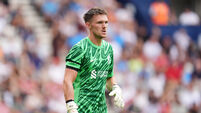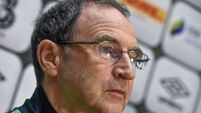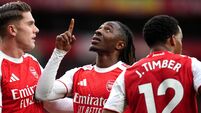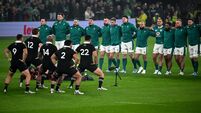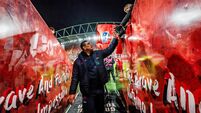Finally convincing the doubters

One thing that cannot be said about Michael Carrick any longer, as the understated midfielder basks in a fifth Premier League title in seven years, is that the midfielder remains under-rated.
Robin van Persie’s arrival from Arsenal has given United a goal threat that has dragged them out of all manner of tight spots on their way to winning the title with four games to spare and establishing a 16-point lead over Manchester City.
But other than van Persie, Carrick, who has made more league appearances than any other United player this season after reaching another highly consistent level of performance over the past two campaigns, is perhaps the only other player that is indispensable to Ferguson’s plans.
Not that Ferguson, who still takes every opportunity to bemoan the fact Tottenham’s David Ginola was named Player of the Year when United won the Treble in 1999, cares particularly, but, other than van Persie, Carrick is his only other United player on the shortlist for the PFA award. And Arsenal manager Arsene Wenger, who hosts United at the Emirates tomorrow, feels Carrick should win it.
But seven years on from his €21.8m move from Tottenham and three months ahead of his 32nd birthday, why are football’s biggest names now falling over each other in their attempts to highlight Carrick’s contribution? Carrick, who inherited Roy Keane’s number 16 shirt, has never been a driving presence and although he won the Premier League in each of his first three seasons, he was often dismissed as a sideways passer, who rarely gave the ball away, partly because he never tried to do much with it.
He has had a similarly peripheral kind of England career, winning just 27 caps since making his international debut in 2001. Much like Ray Wilkins, who was called ‘The Crab’ by United manager Ron Atkinson, Carrick never really had the approval of the fans.
Ferguson always felt that each summer Carrick took time to get going but he always worked his way firmly into the manager’s plans by the end of the campaign and started each of United’s three Champions League finals since he has been at the Old Trafford club.
The spot-kick victory over Chelsea in Moscow in 2008 saw Carrick tick off another major honour. But his performances in the other two finals against Barcelona, particularly the 2-0 defeat in Rome — where it is largely forgotten he played with a broken toe — saw his stock slip significantly and Ferguson tried to sign Luka Modric the following summer.
Against the best of Barcelona two years ago at Wembley, Carrick, utterly ineffective in possession, once again looked out of place and time and again found himself stuck in the middle of Catalan triangles, perhaps the most uncomfortable passenger on what Ferguson described as a “carousel”.
Many put the transformation down to the retirement of Paul Scholes in that summer of 2011 but it took a few weeks into the following campaign for the tide of Carrick’s United career to truly turn.
Ferguson started the campaign with Anderson, enjoying one of his brief spells of form, and Tom Cleverley, who had returned from a successful year on loan at Wigan, in the centre of his midfield.
The Anderson and Cleverley combination helped United to a 2-1 win at West Brom and a 3-0 thumping of Tottenham before Arsenal were taken to pieces in an 8-1 humiliation at Old Trafford until Cleverley suffered an ankle injury in the 5-0 win at Bolton that would disrupt his campaign.
Carrick actually had to wait until November 19 for his first Premier League start, in a 1-0 win at Swansea.
In December 2011, Ferguson made public his long-term frustration with Carrick and he issued a challenge that the midfielder finally answered.
“I think it’s time Michael became the pivotal player of our team,” Ferguson said. “We’ve always known he’s got that in him. He’s a laid-back character – quiet, unassuming – but in different periods during his time here he’s shown his quality.
“Now is the time for him to start a long period of dominating the centre of midfield. He’s grabbed the chance and, in some ways, he’s maybe seen the departure of Paul Scholes as his opportunity to be the main man in midfield.”
Of course Scholes returned the following month but it was to play the remainder of the season alongside Carrick as United were pipped to the title in the final seconds by Sergio Aguero and City.
Ferguson’s vow that United would never again be beaten to a title on goal difference came as he made a statement with the arrival of Van Persie. And perhaps the addition of the Dutchman has been a key reason why Carrick is so much more keen to pass forwards, with 37% of his balls now heading that way compared to 30% in the previous two seasons, specialising with first-time probes into the area for van Persie.
While Cleverley has still to convince, Anderson could finally be sold this summer, Darren Fletcher has been limited by illness and Scholes is tottering towards a permanent retirement, Carrick has revelled in the responsibility and the fans even have a chant for him after all these years.
Ferguson has not invested in his midfield since signing Owen Hargreaves and Anderson in 2007 and this may be the summer that the United manager finally looks to do some reshaping.
But Carrick, the no-nonsense heartbeat of this quietly ruthless United side, will be confident he will quietly excelling at the centre of it once again.
82.3 (top performer Mikel Arteta 85.3)
88.14% (top midfielder Ki-Sung-yeung 92.54)
48.1 (top midfielder Paul Scholes 59.9)
34 (top midfielder Steven Gerrard 93)
4 (top midfielder Steven Gerrard 9)
72 (top midfielder Morgan Schneiderlin 126)
79 (top midfielder Morgan Schneiderlin 141)






